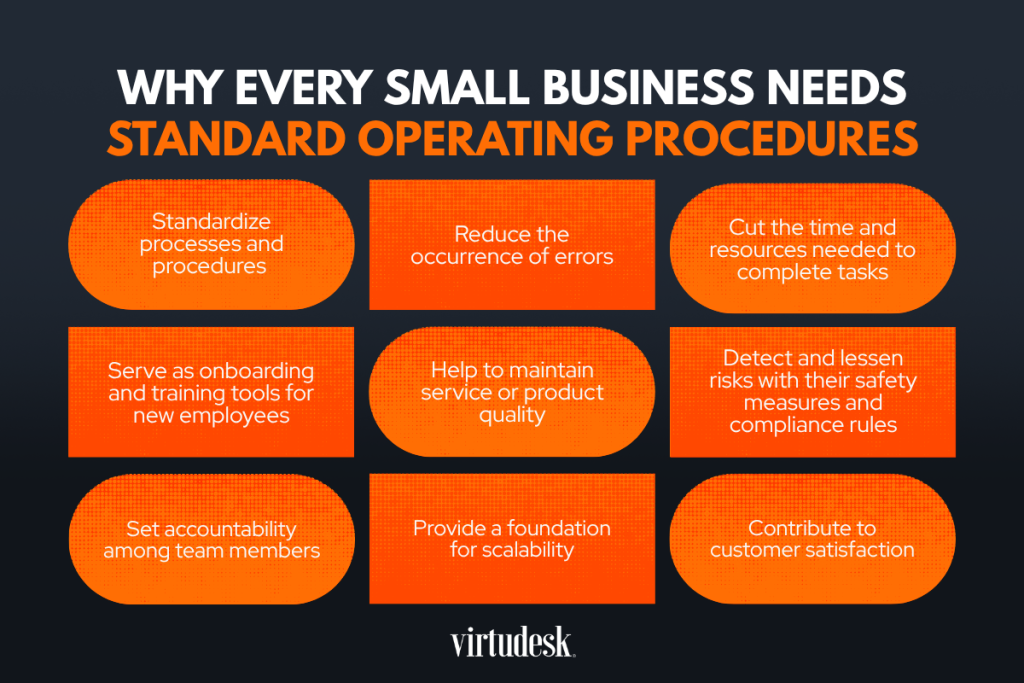How to Build a Business System That Runs Without You
Introduction
Running or leading a company should not imply constantly answering messages, explaining procedures, or fixing every small problem yourself. That’s why you need a business system that runs without you. Besides, if your team needs to wait for your approval or direction on everything they do, your projects, work, and productivity slow down. And so do your gains and growth potential.
A business system that runs without you keeps moving forward even during your absence. Instead of being behind every task, you define clear procedures, select the right tools, and rely on trained employees to carry the daily load.
Today, we’ll see how to record recurring work, write SOPs (Standard Operating Procedures), and delegate tasks, so you can build a functional business system that works with autonomy.
Before stepping into the topic, let’s briefly review some concepts.
Business systems vs business processes vs SOPs
- What’s a business system?
A business system is a group of processes, individuals, and tools used to achieve the business goals. An article published by Forbes defines business systems as the “documented procedures that outline how to do something within your organization to achieve the business goals”.
The scope of a business system is the entire company, and it is changed strategically every few years.
- What’s a business process?
As defined by ISO 9000:2008 and ISO 9001:2015, a business process is a specific sequence of interrelated tasks that convert inputs into outputs to deliver value. For example, customer onboarding or order fulfillment.
Generally reviewed and optimized quarterly or annually, its scope is a defined sequence of actions or activities that transform inputs into value-added outputs (like “Invoice to Cash”).
- What’s an SOP?
An SOP or Standard Operating Procedure is a document or guide with step-by-step instructions to follow for completing a certain task within a process. If you don’t know how to develop an effective SOP, a trained virtual assistant (or VA) can help you with that. Actually, a VA can help you build both systems and SOPs.
The scope of SOPs is the detailed, task-level instructions that explain how to perform an activity or task consistently and correctly (e.g., “How to Process a Refund”). SOPs are frequently modified to accompany process changes, such as those that result from audits or regulatory updates.
This simple analogy summarizes these three concepts without technical definitions:
- The business system is the entire car (including wheels, engine, parts, electronics, and driver).
- The business process would be driving from A to B (it’s the goal-oriented workflow).
- The SOPs would be the driver’s manuals (with step-by-step instructions on how to program the radio or checking the oil levels).
Advantages of a Business System That Runs Without You
The first gain perceived from a business system that runs without you is, for owners, time. They gain time to work on their core tasks and skills or enjoy their personal life without feeling guilty or irresponsible. When work follows clear routes, and your staff owns daily tasks, you start having family dinners or weekend escapes without carrying your laptop.
Another advantage is making better decisions. When you don’t have to rush from email inbox to meetings, or guide/supervise every task, you can concentrate on setting proper prices, outlining strategies, or ideating new products or services. Your employees follow written steps and know what to do without asking you.
Systems also protect your business. If you ever want to bring in new partners or sell your business, you’ll need a business system that runs without you. Partners or potential buyers can see how your business works even if you’re not there. And if you are sick and need to recover in bed, or want to go on vacation to the Caribbean, your business can continue moving forward.
Another win many owners notice is that, once they’re no longer overwhelmed by urgent tasks, stress levels drop. This benefits their physical and mental well-being. Thinking more clearly, you’ll be more patient with your clients and staff and bring positive vibes to the projects that matter most.
If you have a growing business, you may feel that every issue, task, or question lands on you. With a business system that runs without you, your company keeps functioning while you rest, travel, or concentrate on new ideas.
Outsourcing roles and chores to virtual assistants gives you leverage, but only if they have a clear business system. The objective is simple: organize the work so your team (on-site and remote), tools, and standard operating procedures take on the daily load. This way, you’ll only intervene for leadership, direction, and decision-making.
Turn Recurring Work into Business Systems
If you want your business to continue operating “normally” without you, you need accessible, repeatable business systems anyone can follow. There’s no fixed number of systems a business should have; this depends on the business characteristics (size, industry field, complexity). A good start is determining 5 to 10 of your core processes and then creating the systems to support them. HubSpot published a guide recommending seven systems every business must have to succeed.
Tools (software or platforms that handle shared work, communication, and info in one place) are great aids. But they come after you review your recurring tasks, group them into processes and determine clear owners for each.
Identify and list recurring work or tasks
During a week, write down everything you and your staff do. First, you need to identify and list repetitive tasks. Then group them by area. These areas can include, for example: sales, service delivery, marketing, finance and accounting, admin, and operations.
For each group or area, ask yourself and document:
- Which tasks repeat every day, week, or month?
- What triggers each task, and when is each considered “done”?
You can then turn those into standard operating procedures and checklists.
Write simple SOPs and checklists
Clear standard operating procedures have to be at the core of any business system that runs without you. They explain who does what, following which order, and using which tools.
SOPs are important for small businesses. According to the Strategic Finance magazine, they:
- Standardize processes and procedures
- Reduce the occurrence of errors
- Cut the time and resources needed to complete tasks
- Serve as onboarding and training tools for new employees
- Help to maintain service or product quality
- Detect and lessen risks with their safety measures and compliance rules
- Set accountability among team members
- Provide a foundation for scalability
- Contribute to customer satisfaction

For each habitual process, create an SOP that explains:
- Purpose: Why does this process exist?
- Scope: When to run it or not
- Steps: Which steps to follow
- Owner: the person or virtual assistant in charge of updating the SOP
Begin crafting short and clear documents. Your virtual assistant and local staff should be able to follow them without asking for your assistance at each step.
Keep process documentation in one accessible place
Pick a place to house SOPs, checklists, and templates, such as a shared drive or an internal wiki.
Make it easy for your team to search by keyword or client. Enable them to easily find who owns each SOP and see the last update date.
Keep your process documentation in one hub. If you do so, your local and remote staff can find the answers to their questions at any moment. This is particularly significant if you offer 24/7 support, outsource to offshore staff in different time zones, or travel frequently.
Delegation, Outsourcing, and Trust
You might have the best documents, but those won’t help if you still retain every task. Delegation and outsourcing take work off your desk or inbox. Delegating with trust is basic to keep business systems working. Without delegating, outsourcing, and trusting, a self-running business system will remain an idea, not a reality.
Delegating and trust are intrinsically linked. Effective delegation involves trusting your employees to do their work.
Delegation builds trust, empowers employees, and fosters accountability.
Decide what to handle yourself and what to delegate
List which tasks really require your judgment (such as important pricing changes, contracts, major hires, or investments) and delegate the rest.
For example, you can hand over to virtual assistants the following tasks:
- Email and calendar management, CRM updating, report building
- Marketing, social media management, and content creation
- Data entry, documentation creation
- Customer service
There are many more tasks you can outsource to a VA. For more roles you can outsource, check our informative article “What Are the Roles That Could Be Outsourced?”.
You might be thinking that delegating and outsourcing imply managing as well, and that is correct. Fortunately, there are tools for managing virtual assistants and on-site employees that don’t require your constant presence.
For example, with Timedly, our AI-powered time-tracking and monitoring software, you can:
- Stay updated on project progress
- Track attendance and performance
- Manage or monitor your workers from your phone
If you are away or just want to be disconnected, knowing that everything is being monitored and logged is priceless.
The relevance of choosing the right tools for building a business system that runs without you is enormous and undeniable.
Set clear expectations for your remote staff and in-house team
Not setting clear expectations can lead to frustration. Whether you work with local hires or with an outsourced team in the Philippines, you should determine:
- A clearly defined expected result (in plain language)
- Deadlines or required work completion time
- Metrics and KPIs (Key Performance Indicators)
Knowing what and how to do their work, and what is expected from them, gives employees the elements to work with accountability and autonomy.
Build trust through short, regular feedback
Micromanaging and constantly watching over your employees’ shoulders are enemies of trust. Replace continuous messages with:
- A brief weekly check
- Monthly reviews of metrics (and SOPs if needed)
- Periodic feedback and guidance
- Written feedback on sample work saved inside your documentation
Use Smart Technology to Keep Work Moving Without You
To build an owner-independent business system, you need tools to tell your team what to do next and how. When thoughtfully implemented, technology doesn’t just indicate or automate tasks; it preserves intent. That means that your standards, priorities, expectations, and goals continue guiding your team’s work when you’re away.
The goal is to achieve a systemized workflow that complies with your standards and operates predictably without you. That’s how to achieve true business independence and set the foundation for scalable growth.
A smart use of technology tools helps your business with:
- Independence or autonomy: Your business doesn’t paralyze when you’re not there.
- Scalability: You can add clients, projects, or new employees (without increasing your oversight).
To make tech tools become your best partner for independence and growth, we suggest the adoption of tools across these categories:
- CRM (Customer Relationship Management) Platforms (e.g. HubSpot, Zoho, Salesforce): Manage and track your interactions with customers, centralize customer data, automate tasks, provide analytics, and facilitate team collaboration.
- Workflow Automation Tools (e.g. Zapier, Make, Jotform): Optimize business processes by automating repetitive or manual tasks, with rule-based logic, improving efficiency, organization, and productivity. Dig deeper into automation tools as explained by Microsoft.
- Time-tracking and Project Management Tools (e.g. Timedly, Everhour, My Hours): Here’s where time-tracking, project and team management capabilities come together in one solution. Track attendance, working hours, approve timesheets, verify active work with privacy-respecting monitoring such as smart screenshot sampling, and monitor project progress.
- Communication & Collaboration Tools (e.g. Slack, Teams): Help teams work together remotely, share documents, send instant messages, have video meetings and calls, and chat, to mention a few.
The right tools enable delegation and independence; the right people make it effortless and trustworthy. With Virtudesk, you get both, so your business doesn’t merely run without you; it thrives.

Phased Plan to Build a Business System That Runs Without You
Use this four-phase plan as a simple guide, as a starting point. You’ll need to adapt it to your business size, industry, and objectives.
Review your work and pick one area (Phase 1)
- Your goal at this initial step is to spot the areas with the biggest impact.
- Track daily, weekly, and monthly recurring/repetitive tasks.
- Group these tasks by sales, onboarding, finance, delivery, admin, or the ones that suit you better.
- Delegate simple tasks such as data entry, scheduling, and email sorting.
- Use simple tools such as spreadsheets and shared files.
Document and test SOPs (Phase 2)
- Your goal now is to turn tasks into standard operating procedures.
- Draft short SOPs, test them with your local or remote teams, and iterate based on feedback.
- Delegate tasks such as drafting steps, gathering feedback, and taking screenshots.
- Add a shared drive, an internal wiki, and SOP templates as helping tools.
Add delegation and outsourcing (Phase 3)
- Make getting daily work off your desk your goal.
- Keep owner-only tasks, and delegate the rest to your local staff and/or virtual assistants.
- Delegate tasks such as email handling, CRM updating, report creation, and social media management.
- The suggested tools can now include email with configured rules (to avoid chaos in the inbox), CRM solutions, communication tools, and project management software.
Add tech, workflow automation tools, and time-tracking (Phase 4)
- At this point, the goal is to make the business start running without you and scale.
- Create boards, set up workflow automation tools, and start tracking time, performance, and productivity.
- Make CRM, project management tools, workflow automations, and time-tracking and monitoring your regular tools.

Common Mistakes That Keep You Inside Your Business
It’s common to see owners starting with good plans and failing after a few steps. Watch for these repeated mistakes, and build a business system that runs without you:
- Writing excessively long SOPs that nobody reads. Keep them short, clear, and handy.
- Buying project management tools before designing the basic processes. First, determine how work should flow and then get the tools that align with it.
- Hiring virtual assistants without clear goals or training. Every employee, even the most trained, needs to know exactly what’s expected from them.
- Ignoring metrics. If you don’t track metrics, you can’t evaluate if delegation and outsourcing are succeeding and adding value.
Conclusion
You don’t need to keep working late at night or skip vacations. You need to build a business system that runs without you, fueled by:
- Clear business systems
- Goal-oriented processes
- Standard operating procedures
- Smart delegation (including outsourcing to trained virtual assistants through a reliable business service provider)
- Adoption of the tech tools that align with your business needs
If you are ready for the challenge and willing to gain freedom while your business keeps functioning and expanding, contact us. At Virtudesk, we help business owners build systems that maximize time and resources towards growth, business autonomy, and hassle-free scalability.
Get in touch with us by dialing 1(800) 470-8136, or filling out our contact form to schedule a free discovery call. Own your business; don’t let it own you.
Share this article
Meet our Most Trusted
Partners & Clients

Byron Lazine
Co-Founding Chief-of-Operations at BAM (Broke Agent Media)I’ve been using Virtual Assistants for years throughout all of my companies. Once we found Virtudesk the process got even easier and allowed us to scale out our hiring. Highly skilled and accountable professionals. 100% recommend!

Rebecca Julianna James
Realtor / Content CreatorBefore getting started with Virtudesk I had my doubts that they would find what I was looking for. I needed a very particular person to add to my team and let me tell you I am highly pleased! My virtual assistant Myril is the best! I am excited to grow my socialmedia accounts with her. Thank you Virtudesk!

Chelsea Erickson
Realtor La Belle RE GroupI am very happy with the assistance Virtudesk is providing for my real estate business. This is a newer position for my company and we are working through the creation and efficiency.















